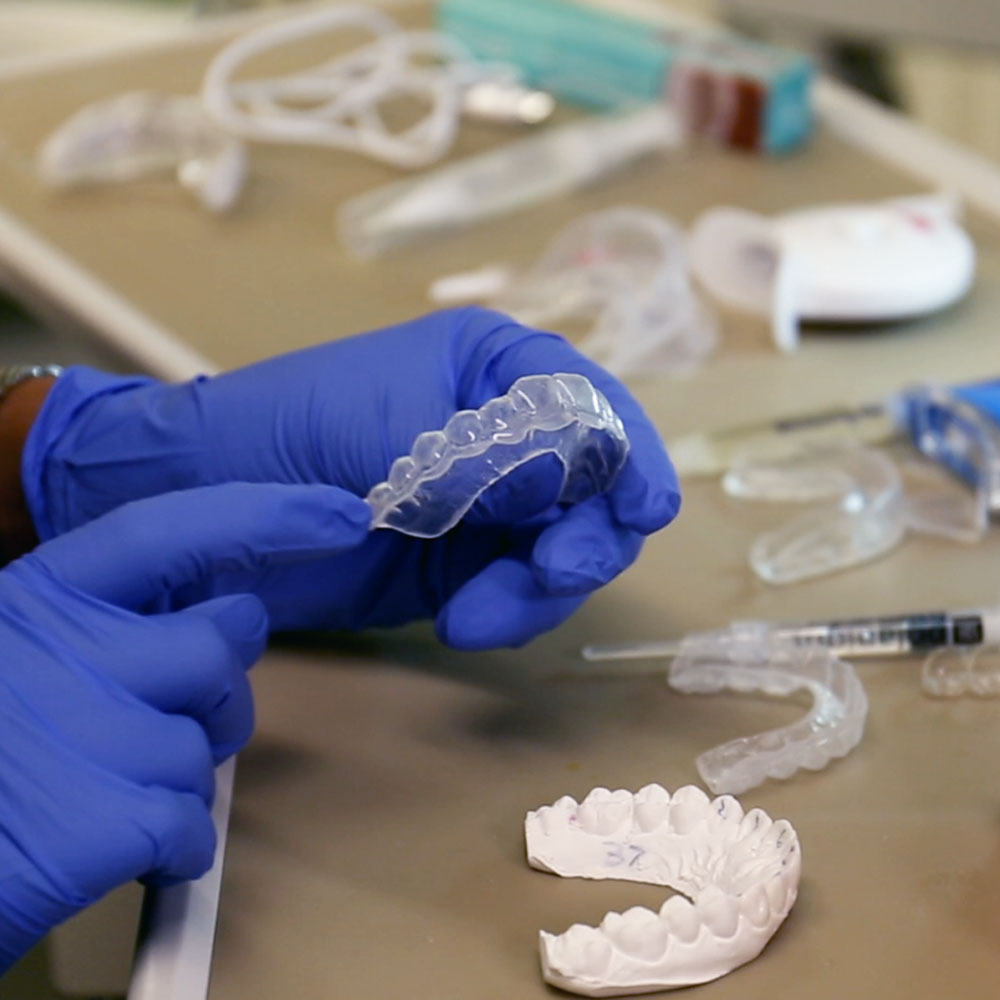Most people are familiar with hydrogen peroxide and might even have that familiar brown bottle in their medicine cabinet. In addition to its disinfectant properties, it is also a main ingredient in teeth whitening products. People may be less aware of carbamide peroxide, but it, too, can whiten teeth.
Whether going to the dentist for teeth whitening or doing it at home, there might be confusion about choosing a whitener with hydrogen vs. carbamide peroxide. Does one work better or last longer? Are they both safe? Although not exactly interchangeable, the differences between the two may not be as significant as one might think.
How Peroxide Solutions Brighten Teeth
A peroxide is defined as any compound containing two oxygen atoms. Adding hydrogen makes hydrogen peroxide, which is an oxidizing agent. This means that it can cause a chemical reaction where the oxygen atoms lose electrons, altering the substance it is applied to. In the case of teeth whitening, hydrogen peroxide brings about a chemical reaction that works at dissolving the stains on teeth.
Carbamide peroxide is a combination of hydrogen peroxide and another chemical compound called carbamide or urea. While it has a slightly different chemical makeup, carbamide peroxide is also an oxidizing agent and works on stains in the same way that hydrogen peroxide does.
How Hydrogen and Carbamide Peroxide Teeth Whitening Differs

Hydrogen peroxide and carbamide peroxide both change the chemical composition of stains when they are applied to teeth. For this reason they are sometimes called bleaching agents rather than whitening agents. While many dentists don’t distinguish between the two terms, bleaching usually refers to the use of chemicals to change the shade of the tooth enamel, whereas whitening is simply removing surface stains caused by things like coffee or wine.
Both compounds are applied to the teeth by the dentist in the form of a gel, or worn at home in trays that fit over the teeth.
Carbamide peroxide’s oxidizing power releases in the first 2 hours, then it continues to work for up to 6 more hours. Because it spends more time in contact with the teeth, it is often used in products that are worn overnight.
Hydrogen peroxide breaks down faster and does most of its work in the first 30 to 60 minutes. This is more likely to be used at the dentist’s office where a dental professional brushes it on and cleans it off while the patient is in the office.
Both types of peroxide solutions break down, becoming water when exposed to light. This is why hydrogen peroxide is sold in brown rather than clear bottles at the store. Carbamide peroxide contains hydrogen peroxide in a 1:3 ratio. This means that a 30% carbamide solution has only 10% hydrogen peroxide. It too can change to water, but at a much slower rate.
Teeth Whitening and Tooth Sensitivity
Teeth whitening using hydrogen peroxide and carbamide peroxide is safe when done properly. Any type of whitening treatment can cause short-term sensitivity though. Using whitening products too often or leaving them on too long can make the situation worse.
The fact that carbamide peroxide takes longer to break down and is usually left on teeth longer means that the sensitivity can be a bit more intense. It may also cause more irritation to the gums, especially if precautions are not taken to protect them from contact with the chemicals.
Most patients, however, do not see much difference in carbamide vs. hydrogen peroxide when it comes to sensitivity. Going to a dental professional for treatment is the best way to avoid any issues. And as long as care is taken to use over-the-counter products correctly, at-home whitening with either product should not cause teeth to be unusually sensitive.
Success Rate of Carbamide Peroxide Teeth Whitening
As bleaching agents, both hydrogen and carbamide peroxide are equally effective. A study conducted by the American Dental Association found that initially, patients using carbamide peroxide had a more significant change. But after 12 weeks, the results were the same for teeth treated with hydrogen peroxide and carbamide peroxide.
Dentists also see little difference in “rebound.” Rebound is a term used to describe an initial dramatic change in shade that disappears within a few days. Both carbamide and hydrogen peroxide produce effects that last for a comparable period of time.
No whitening is permanent, however. Depending on the type of treatment and degree of staining, whitening can last months or even years. But eventually it will need to be refreshed to maintain the desired shade of white.
Teeth Whitening on Different Types of Stains

Tooth discoloration can come from external sources (extrinsic) that cause surface stains. Things like smoking, red wine, coffee, and tea create these stains. Many over-the-counter products can help with this type of discoloration by giving the teeth a deep cleaning. They may include a peroxide solution, or just abrasive ingredients to scrub away stains.
Harder to remove are intrinsic stains caused by heredity, aging, tooth decay, or some medications. In some cases, even the most powerful whiteners will have no effect.
If the stains are removable, both carbamide and hydrogen peroxide will do an equally good job. The compounds do more than just clean, they break down the chemical makeup of the stain so it disappears little by little with each treatment.
Teeth Whitening Choices
Before any teeth whitening is attempted, patients should check with their dentist to make sure their teeth are healthy. If tooth decay is present, the harsh chemicals can cause pain beyond the normal, mild sensitivity that is expected with teeth whitening.
The drugstore and online marketplace is filled with a variety of whitening toothpaste, rinses, gel strips, and trays. Some of these contain either hydrogen peroxide or carbamide peroxide. At-home products may be fine for some stains, but they are less powerful. They typically contain peroxide in a concentration of 3% to 10%.
Dentists have the advantage of access to much stronger chemicals because they are offering them in a controlled, professional environment. They may use peroxide solutions up to about 40%. Their supervision during treatment will ensure that the teeth and gums are protected and that the desired effect is achieved without over bleaching.
Seeing the dentist for whitening also has the advantage of their expertise about what will work best on the particular stains in a patient’s mouth. They may suggest a special product or procedure such as Zoom! or laser teeth whitening for the best results.
If there is no hope in changing certain stains, a dentist can discuss other options. Veneers or dental bonding can completely cover teeth with permanent intrinsic stains or that are beyond repair.
Consider Teeth Whitening With a Dentist
Teeth whitening is a popular and effective way to refresh the appearance of your smile. Carbamide peroxide, like hydrogen peroxide, either at home or at the dentist’s office can help you achieve that goal. If you’d like to find a dentist who offers teeth whitening, use our online search tool and make an appointment for a consultation.


